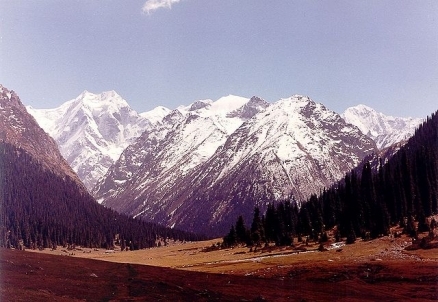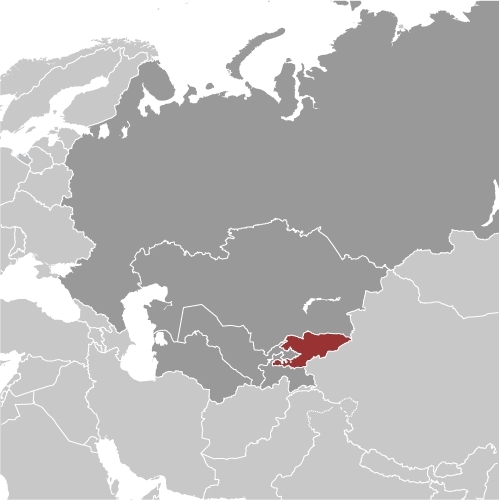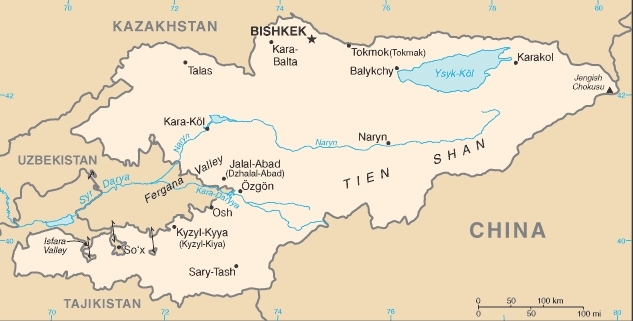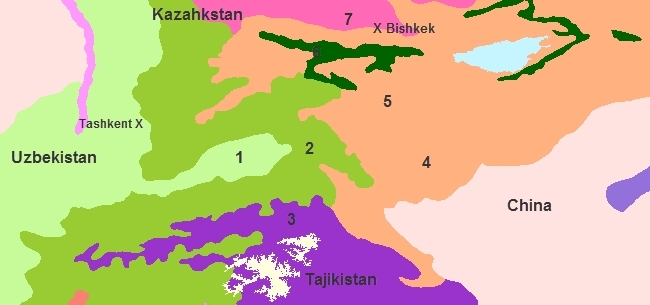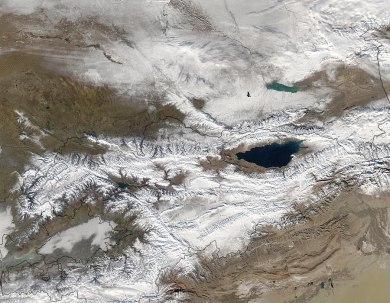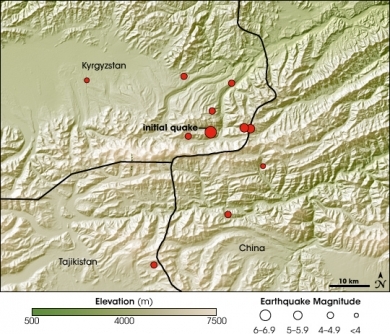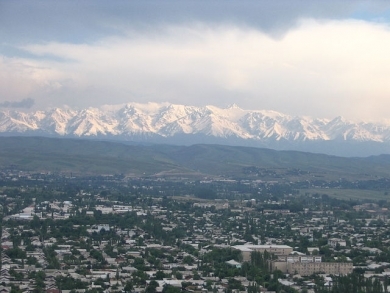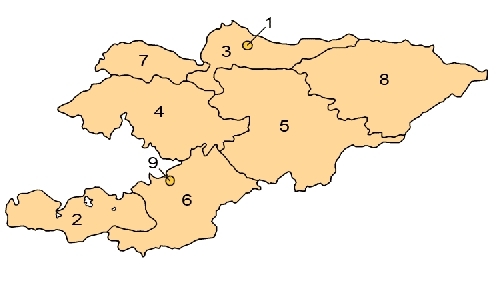Kyrgyzstan
Kyrgyzstan is a landlocked nation of five-and-a-half million people in central Asia, west of China, south of Kazakhstan.
Kyrgyzstan entirely mountainous, dominated by the Tien Shan range.94% of the country is 1,000 m above sea level with an average elevation of 2,750 m. It has many tall peaks, glaciers, and high-altitude lakes, including Lake Issyk-Kul, the world’s second largest alpine lake.
Its major environmental issues include:
- water pollution; many people get their water directly from contaminated streams and wells; as a result, water-borne diseases are prevalent;
- increasing soil salinity from faulty irrigation practices
Kyrgyzstan has the world's largest natural-growth walnut forest.
A Central Asian country of incredible natural beauty and proud nomadic traditions, most of Kyrgyzstan was formally annexed to Russia in 1876.
The Kyrgyz staged a major revolt against the Tsarist Empire in 1916 in which almost one-sixth of the Kyrgyz population was killed. Kyrgyzstan became a Soviet republic in 1936 and achieved independence in 1991 when the USSR dissolved.
Nationwide demonstrations in the spring of 2005 resulted in the ouster of President Askar Akaev, who had run the country since 1990. Subsequent presidential elections in July 2005 were won overwhelmingly by former prime minister Kurmanbek Bakiev. Over the next few years, the new president manipulated the parliament to accrue new powers for himself. In July 2009, after months of harassment against his opponents and media critics, Bakiev won re-election in a presidential campaign that the international community deemed flawed.
In April 2010, nationwide protests led to the resignation and expulsion of Bakiev. His successor, Roza Otunbaeva, served as transitional president until Almazbek Atambayev was inaugurated in December 2011.
Continuing concerns include: endemic corruption, poor interethnic relations, and terrorism.
Kyrgyzstan has yet to ratify the 2001 boundary delimitation with Kazakhstan. It also has disputes in the Isfara Valley which delay completion of delimitation with Tajikistan. Delimitation of 130 km of border with Uzbekistan is hampered by serious disputes around enclaves and other areas
Contents
Geography
Location: Central Asia, west of China, south of Kazakhstan
Geographic Coordinates: 41 00 N, 75 00 E
Area: 199,951 sq km (land: 191,801 sq km; water: 8,150 sq km)
Land Boundaries: 3,051 km (China 858 km, Kazakhstan 1,224 km, Tajikistan 870 km, Uzbekistan 1,099 km)
Terrain: peaks of Tien Shan and associated valleys and basins encompass entire nation. The highest point is Jengish Chokusu (Pik Pobedy) (7,439 m) and the lowest point Kara-Daryya (Karadar'ya) (132 m)
Climate: dry continental to polar in high Tien Shan Mountains; subtropical in southwest (Fergana Valley); temperate in northern foothill zone
Topography of Kyrgyzstan. Source: Wikimedia Commons.
Ecology and Biodiversity
- Alai-Western Tian Shan steppe
- Gissaro-Alai open woodlands
- Pamir alpine desert and tundra
- Tian Shan montane steppe and meadows
- Tian Shan foothill arid steppe
- Tian Shan montane conifer forests
- Central Asian northern desert
Map source: World Wildlife Fund
See also:Biological diversity in the mountains of Central Asia
People and Society
Population: 5,496,737 (July 2012 est.)
Ethnic Groups: Kyrgyz 64.9%, Uzbek 13.8%, Russian 12.5%, Dungan 1.1%, Ukrainian 1%, Uighur 1%, other 5.7% (1999 census)
Age Structure:
0-14 years: 29.3% (male 834,024/female 801,750)
15-64 years: 65.4% (male 1,790,534/female 1,865,521)
65 years and over: 5.3% (male 114,200/female 181,414) (2011 est.)
Population Growth Rate: 0.887% (2012 est.)
Birthrate: 23.9 births/1,000 population (2012 est.)
|
Silvery snow highlights the Tian Shan and Pamir Alay Mountains that dominate Kyrgyzstan, image center. As this image shows, about 95 percent of this Central Asian republic is covered with mountains. Its highest point is Pik Pobedy, or Victory Peak, on its extreme eastern boarder, with an impressive elevation of 24,406 feet (7439 meters), 4,620 feet lower than Mount Everest. Nestled between the Küngey Alatau and the Terskey Alatau ranges in eastern Kyrgyzstan is Lake Issyk-Kul, the world’s second largest alpine lake behind Lake Titicaca in South America. This Moderate Resolution Imaging Spectroradiometer (MODIS) image was captured by the Aqua satellite on December 3, 2003. Starting at the top and going clockwise, the countries that surround Kyrgyzstan are Kazakhstan, China, Tajikistan, and Uzbekistan. A former Soviet state, Kyrgyzstan gained its independence from the Soviet Union in 1991. |
|
On October 5, 2008, at 9:52 p.m., a magnitude 6.6 earthquake shook eastern Kyrgyzstan. This image, made with elevation data from the Shuttle Radar Topography Mission, shows something of the basic geology behind the powerful quake. Kyrgyzstan is made up of steep mountains, with two peaks rising to an elevation greater than 7,000 meters (about 23,000 feet). The tectonic forces that created the rugged and breathtaking scenery also put the landlocked country at great risk for earthquakes. The mountains formed as the Asian continent in the north folded under pressure in the ongoing collision with the Indian subcontinent to the south. As the landmass that contains India continues to move north, the Himalaya Mountains and the Tibetan Plateau rise by as much as a centimeter per year. In addition to adding elevation, the Tibetan Plateau also pushes north, and this motion is creating the mountains of Central Asia. The process of mountain building continues, and earthquakes are an inevitable part of the process. Made up of mountains, Kyrgyzstan is frequently rattled by large earthquakes. The October 5 earthquake was centered in the Tien Shan Mountains near the Chinese border. Several moderate-sized aftershocks followed, and are represented on this map by red circles. As of October 6, the full impact of the earthquake was still unknown, said the United Nations Office for the Coordination of Humanitarian Affairs (OCHA). The earthquake damaged the main road into the quake-hit region, making access for aid and damage assessment difficult. Sixty people died in the small village of Nura, which was nearly entirely destroyed, said OCHA. The Associated Press reported that the overall death toll had reached 74 by October 7. NASA image created by Jesse Allen, using Shuttle Radar Topography Mission (SRTM) data provided by the University of Maryland’s Global Land Cover Facility. Caption by Holli Riebeek. |
| City of Osh. Source: Wikimedia Commons. |
| Bishkek. Source: Wikimedia Commons. |
Death Rate: 6.93 deaths/1,000 population (July 2012 est.)
Net Migration Rate: -8.1 migrant(s)/1,000 population (2012 est.)
Life Expectancy at Birth: 69.45 years
male: 65.27 years
female: 73.91 years (2012 est.)
Total Fertility Rate: 2.73 children born/woman (2012 est.)
Languages: Kyrgyz (official) 64.7%, Uzbek 13.6%, Russian (official) 12.5%, Dungun 1%, other 8.2% (1999 census)
Literacy (age 15 and over can read and write): 98.7% (1999 census)
Urbanization: 35% of total population (2010) growing at an annual rate of change of 1.3% (2010-15 est.)
History
According to recent findings of Kyrgyz and Chinese historians, Kyrgyz history dates back to 201 B.C. The earliest descendents of the Kyrgyz people, who are believed to be of Turkic descent, lived in the northeastern part of what is currently Mongolia. Later, some of their tribes migrated to the region that is currently southern Siberia and settled along the Yenisey River, where they lived from the 6th until the 8th centuries. They spread across what is now the Tuva region of the Russian Federation, remaining in that area until the rise of the Mongol Empire in the 13th century, when the Kyrgyz began migrating south. In the 12th century, Islam became the predominant religion in the region. Most Kyrgyz are Sunni Muslims of the Hanafi school.
During the 15th-16th centuries, the Kyrgyz people settled in the territory currently known as the Kyrgyz Republic. In the early 19th century, the southern territory of the Kyrgyz Republic came under the control of the Khanate of Kokand, and the territory was formally incorporated into the Russian Empire in 1876. The Russian takeover instigated numerous revolts against tsarist authority, and many Kyrgyz opted to move into the Pamir mountains or to Afghanistan. The suppression of the 1916 rebellion in Central Asia caused many Kyrgyz to migrate to China.
Soviet power was initially established in the region in 1918, and in 1924, the Kara-Kyrgyz Autonomous Oblast was created within the Russian Federal Socialist Republic. (The term Kara-Kyrgyz was used until the mid-1920s by the Russians to distinguish them from the Kazakhs, who were also referred to as Kyrgyz.) In 1926, it became the Kyrgyz Autonomous Soviet Socialist Republic. On December 5, 1936, the Kyrgyz Soviet Socialist Republic (SSR) was established as a full Union Republic of the U.S.S.R.
During the 1920s, the Kyrgyz Republic saw considerable cultural, educational, and social change. Economic and social development also was notable. Literacy increased, and a standard literary language was introduced. The Kyrgyz language belongs to the Southern Turkic group of languages. In 1924, an Arabic-based Kyrgyz alphabet was introduced, which was replaced by Latin script in 1928. In 1941 Cyrillic script was adopted. Many aspects of the Kyrgyz national culture were retained despite suppression of nationalist activity under Joseph Stalin, who controlled the Soviet Union from the late 1920s until 1953.
The early years of glasnost in the late 1980s had little effect on the political climate in the Kyrgyz Republic. However, the republic's press was permitted to adopt a more liberal stance and to establish a new publication, Literaturny Kirghizstan, by the Union of Writers. Unofficial political groups were forbidden, but several groups that emerged in 1989 to deal with an acute housing crisis were permitted to function.
In June 1990, ethnic tensions between Uzbeks and Kyrgyz surfaced in an area of the Osh Oblast, where Uzbeks form a majority of the population. Violent confrontations ensued, and a state of emergency and curfew were introduced. Order was not restored until August 1990.
The early 1990s brought measurable change to the Kyrgyz Republic. The Kyrgyzstan Democratic Movement (KDM) had developed into a significant political force with support in parliament. In an upset victory, Askar Akayev, the president of the Kyrgyz Academy of Sciences, was elected to the presidency in October 1990. The following January, Akayev introduced new government structures and appointed a new government comprised mainly of younger, reform-oriented politicians. In December 1990, the Supreme Soviet voted to change the republic's name to the Republic of Kyrgyzstan. (In 1993, it became the Kyrgyz Republic.) In February 1991, the name of the capital, Frunze, was changed back to its pre-revolutionary name--Bishkek.
Despite these moves toward independence, economic realities seemed to work against secession from the U.S.S.R. In a referendum on the preservation of the U.S.S.R. in March 1991, 88.7% of the voters approved a proposal to retain the U.S.S.R. as a "renewed federation."
On August 19, 1991, when the State Committee for the State of Emergency (SCSE) assumed power in Moscow, there was an attempt to depose Akayev in Kyrgyzstan. After the coup collapsed the following week, Akayev and Vice President German Kuznetsov announced their resignations from the Communist Party of the Soviet Union (CPSU), and the entire politburo and secretariat resigned. This was followed by the Supreme Soviet vote declaring independence from the U.S.S.R. on August 31, 1991. Kyrgyz was announced as the state language in September 1991. (In December 2001, through a constitutional amendment, the Russian language was given official status.)
In October 1991, Akayev ran unopposed and was elected President of the new independent republic by direct ballot, receiving 95% of the votes cast. Together with the representatives of seven other republics, he signed the Treaty of the New Economic Community that same month. On December 21, 1991, the Kyrgyz Republic formally entered the new Commonwealth of Independent States (CIS).
In 1993, allegations of corruption against Akayev's closest political associates blossomed into a major scandal. One of those accused of improprieties was Prime Minister Chyngyshev, who was dismissed for ethical reasons in December. Following Chyngyshev's dismissal, Akayev dismissed the government and called upon the last communist premier, Apas Djumagulov, to form a new one. In January 1994, Akayev initiated a referendum asking for a renewed mandate to complete his term of office. He received 96.2% of the vote.
A new constitution was passed by the parliament in May 1993. In 1994, however, the parliament failed to produce a quorum for its last scheduled session prior to the expiration of its term in February 1995. President Akayev was widely accused of having manipulated a boycott by a majority of the parliamentarians. Akayev, in turn, asserted that the communists had caused a political crisis by preventing the legislature from fulfilling its role. Akayev scheduled an October 1994 referendum, overwhelmingly approved by voters, which proposed two amendments to the constitution--one that would allow the constitution to be amended by means of a referendum, and the other creating a new bicameral parliament called the Jogorku Kenesh.
Elections for the two legislative chambers--a 35-seat full-time assembly and a 70-seat part-time assembly--were held in February 1995 after campaigns considered remarkably free and open by most international observers, although the election-day proceedings were marred by widespread irregularities. Independent candidates won most of the seats, suggesting that personalities prevailed over ideologies. The new parliament convened its initial session in March 1995. One of its first orders of business was the approval of the precise constitutional language on the role of the legislature.
On December 24, 1995, President Akayev was reelected for another 5-year term with wide support (75% of vote) over two opposing candidates. President Akayev used government resources and state-owned media to carry out his campaign. Three (out of six) candidates were deregistered shortly before the election.
A February 1996 referendum--in violation of the constitution and the law on referendums--amended the constitution to give President Akayev more power. Although the changes gave the president the power to dissolve parliament, it also more clearly defined the parliament's powers. Since that time, the parliament has demonstrated real independence from the executive branch.
An October 1998 referendum approved constitutional changes, including increasing the number of deputies in the lower house, reducing the number of deputies in the upper house, providing for 25% of lower house deputies to be elected by party lists, rolling back parliamentary immunity, introducing private property, prohibiting adoption of laws restricting freedom of speech and mass media, and reforming the state budget.
Two rounds of parliamentary elections were held on February 20, 2000 and March 12, 2000. With the full backing of the United States, the Organization for Security and Cooperation in Europe (OSCE) reported that the elections failed to comply with commitments to free and fair elections and hence were invalid. Questionable judicial proceedings against opposition candidates and parties limited the choice of candidates available to Kyrgyz voters, while state-controlled media only reported favorably on official candidates. Government officials put pressure on independent media outlets that favored the opposition. The presidential election that followed later in 2000 also was marred by irregularities and was not declared free and fair by international observers.
March 2002 events in the southern district of Aksy, where six people protesting the arbitrary arrest of an opposition politician were shot dead by police, engendered nationwide protests. President Akayev initiated a constitutional reform process, which initially included the participation of a broad range of government, civil, and social representatives in an open dialogue. The reform process resulted in a February 2003 referendum, which was marred by voting irregularities. The amendments to the constitution approved by the referendum resulted in further control by the president and weakened the parliament and the Constitutional Court. Under the new constitution, the previously bicameral parliament became a 75-seat unicameral legislature following the 2005 parliamentary elections.
Parliamentary elections were held February 27 and March 13, 2005. The United States agreed with the findings of the OSCE that while the elections failed to comply with commitments to free and fair elections, there were improvements over the 2000 elections, notably the use of indelible ink, transparent ballot boxes, and generally good access by election observers.
Sporadic protests against widespread fraud during the parliamentary runoff elections in March 2005 erupted into calls for the government to resign. By March 24, 15,000 pro-opposition demonstrators called for the resignation of the president and his regime in Bishkek. Some injuries were reported when opposition demonstrators were attacked by police and pro-government thugs. Protestors seized the presidential administration building, after which President Akayev left the country for Kazakhstan, and then Russia. Looting broke out in parts of Bishkek on the evening of March 24, causing an estimated $100 million in damage.
Opposition leaders, caught by surprise by developments, moved to form a broadly inclusive "Committee of National Unity." Opposition leader Kurmanbek Bakiyev was named acting President and Prime Minister. Bakiyev formed an alliance with primary rival Feliks Kulov whereby Kulov agreed to drop out of the presidential race if Bakiyev appointed him Prime Minister upon winning the elections.
Bakiyev easily won the July 10, 2005 presidential elections with over 88% of the vote. An unprecedented number of domestic and international observers monitored the elections and noted significant improvements in the electoral process over the parliamentary elections, although there were some reports of irregularities.
Opposition groups held a series of demonstrations in 2006, including the entire first week of November, to protest the lack of progress on reform, in particular of the constitution, promised by President Bakiyev in 2005. The Kyrgyz parliament adopted amendments to the constitution and President Bakiyev signed the amended constitution on November 9, 2006, which limited the powers of the president and increased the role of parliament. After the government resigned on December 19, the Kyrgyz parliament voted on December 30 to adopt new amendments restoring some of the presidential powers lost in November. President Bakiyev signed the changes into law January 15, 2007.
In March 2007, President Bakiyev appointed opposition leader Almaz Atambayev as Prime Minister. A week-long opposition protest in April 2007 ended when police cleared the main Ala-Too Square in Bishkek.
In September 2007, the Constitutional Court invalidated the November 2006 and December 2006 versions of the constitution. President Bakiyev then called a snap national referendum on a new version of the constitution, which strengthened the powers of the president and provided for a parliament elected by party lists. The new constitution was approved in an October 2007 referendum that was marked by serious irregularities, including massive inflation of turnout figures. President Bakiyev then dissolved the parliament, calling for new elections. The December 2007 elections were deeply flawed, with the new pro-presidential Ak Jol party gaining 71 out of 90 seats. The largest opposition party, Ata Meken, did not gain any seats, despite probably receiving enough votes to meet the regional thresholds required to enter parliament. Following the elections, a government was formed headed by the former energy minister, Igor Chudinov, as Prime Minister.
On July 23, 2009 President Bakiyev was overwhelmingly reelected with 76% of the vote, although the OSCE noted numerous voting irregularities. In October 2009, Daniyar Usenov was nominated as Prime Minister. Protests in April 2010 in the town of Talas and in Bishkek ousted Bakiyev and his government from office. A provisional government headed by President Roza Otunbayeva took office in April and navigated through brief but intense interethnic clashes in June 2010 to organize a referendum on June 27, 2010, by which voters approved a new constitution. The referendum also confirmed Otunbayeva as President until December 31, 2011.
The 2010 constitution is intended to limit presidential power and enhance the role of parliament and the prime minister. Parliamentary elections were held in October 2010. The elections were highly competitive and peaceful, Five parties entered parliament, led by the Ata Jurt party (28 seats), and followed by the Social Democratic Party of Kyrgyzstan (26 seats), Ar-Namys (25 seats), Respublika (23 seats) and Ata-Meken (18 seats). Three parties (Ata Jurt, SDPK, and Respublika) formed a governing coalition with Almazbek Atambayev as prime minister.
Because the 2010 constitutional referendum limited Roza Otunbayeva’s term in office until the end of 2011, Kyrgyzstan held a presidential election on October 30, 2011. Almazbek Atambayev of the Social Democratic Party of Kyrgyzstan won the first round with 63 percent of the vote, thus avoiding the possibility of a second-round runoff. The 2011 election was democratic and peaceful, but some observers noted areas for improvement. Atambayev’s inauguration on December 1, 2011 marked the first peaceful and democratic transfer of presidential power in Central Asia. With Atambayev vacating the office of prime minister, party factions consulted to organize a new government. A new governing coalition was formed consisting of SDPK, Respublika, Ata-Meken and Ar-Namys. Parliament approved the new government on December 23, 2011, with Omurbek Babanov (leader of the Respublika faction) as the new prime minister.
Government
The 2010 constitution defines the Kyrgyz Republic as a sovereign, democratic, secular, unitary, and social state. The executive branch is headed by the prime minister and government, though the president retains numerous constitutional powers as head of state. The president is elected to a six year term and may only serve once. The judicial branch comprises a Supreme Court and local courts. The legislative branch is composed of a 120-member unicameral parliament. The cabinet consists of three Vice Prime Ministers, fifteen ministries and the State Committee for National Security.
Government Type: Republic
Capital: Bishkek: 854,000 (2009)
Administrative divisions: 7 provinces (oblastlar, singular - oblasty) and 1 city* (shaar);
Note: administrative divisions have the same names as their administrative centers (exceptions have the administrative center name following in parentheses) |
Independence Date: 31 August 1991 (from the Soviet Union)
Legal System: civil law system which includes features of French civil law and Russian Federation laws. Kyrgyzstan has not submitted an International Court of Justice (ICJ) jurisdictiondeclaration; and, is a non-party state to the International criminal court (ICCt).
International Environmental Agreements
Kyrgyzstan is party to international agrements on: Air Pollution, Biodiversity, Climate Change, Climate Change-Kyoto Protocol, Desertification, Hazardous Wastes, Ozone Layer Protection, and Wetlands.
Water
Total Renewable Water Resources: 46.5 cu km (1997)
Freshwater Withdrawal: 10.08 cu km/yr (3% domestic, 3% industrial, 94% agricultural)
Per Capita Freshwater Withdrawal: 1,916 cu m/yr (2000)
See: Water profile of Kyrgyzstan
Agriculture
Agriculture is an important sector of the economy in the Kyrgyz Republic. By the early 1990s, the private agricultural sector provided between one-third and one-half of some harvests. In 2010 agriculture accounted for 55% of GDP and about 32% employment. The Kyrgyz Republic's terrain is mountainous, which accommodates livestock raising, the largest agricultural activity. Main crops include wheat, sugar beets, cotton, tobacco, vegetables, and fruit. Wool, meat, and dairy products also are major commodities. Agricultural processing is a key component of the industrial economy, as well as one of the most attractive sectors for foreign investment.
Agricultural products: tobacco, cotton, potatoes, vegetables, grapes, fruits and berries; sheep, goats, cattle, wool
Irrigated Land: 10,196 sq km (2008)
Resources
The Kyrgyz Republic is rich in mineral resources but has negligible petroleum and natural gas reserves; it imports petroleum and gas. Among its mineral reserves are substantial deposits of coal, gold, uranium, antimony, and other rare-earth metals. The government hopes to attract foreign investment in mining and metallurgy, but local business conditions are very challenging to most companies. The Kyrgyz Republic's plentiful water resources and mountainous terrain enable it to produce and export large quantities of hydroelectric energy.
The Kyrgyz Republic's principal exports are nonferrous metals (primarily gold) and minerals, woolen goods and other agricultural products, electric energy, and certain engineering goods. Its imports include petroleum and natural gas, ferrous metals, chemicals, most machinery, wood and paper products, some foods, and some construction materials. Its leading trade partners include Switzerland, Russia, China, and neighboring Kazakhstan and Uzbekistan.
The Kyrgyz Republic exports antimony, mercury, rare-earth metals, and chemical products to the United States. It imports grain, medicine and medical equipment, vegetable oil, paper products, rice, machinery, agricultural equipment, and meat from the United States. In 2010 Kyrgyz exports to the U.S. totaled $90.3 million; 2010 Kyrgyz imports from the U.S. totaled $188.2 million, much of which consisted of vehicles, poultry meat and equipment.
Natural Resources: abundant hydropower; significant deposits of gold and rare earth metals; locally exploitable coal, oil, and natural gas; other deposits of nepheline, mercury, bismuth, lead, and zinc.
Land Use:
Economy
Kyrgyzstan is a poor, mountainous country with a dominant agricultural sector. Cotton, tobacco, wool, and meat are the main agricultural products, although only tobacco and cotton are exported in any quantity.
Industrial exports include gold, mercury, uranium, natural gas, and electricity.
The economy depends heavily on gold exports - mainly from output at the Kumtor gold mine.
Following independence, Kyrgyzstan was progressive in carrying out market reforms, such as an improved regulatory system and land reform. Kyrgyzstan was the first Commonwealth of Independent States (CIS) country to be accepted into the World Trade Organization. Much of the government's stock in enterprises has been sold.
Despite the backing of major Western donors, including the International Monetary Fund (IMF), the Kyrgyz Republic has had economic difficulties following independence. Initially, these were a result of the breakup of the Soviet trading bloc and resulting loss of markets, which impeded the republic's transition to a free market economy. Through economic stabilization and reform, the government seeks to establish a pattern of long-term consistent growth. Reforms led to the Kyrgyz Republic's accession to the World Trade Organization (WTO) on December 20, 1998.
The Kyrgyz Republic's economy was severely affected by the collapse of the Soviet Union and the resulting loss of its vast market. In 1990, some 98% of Kyrgyz exports went to other parts of the Soviet Union. Thus, the nation's economic performance in the early 1990s was worse than any other former Soviet republic except war-torn Armenia, Azerbaijan, and Tajikistan. While economic performance has improved in the last few years, difficulties remain in securing adequate fiscal revenues and providing a sufficient social safety net.
In 2005, the Bakiev government and international financial institutions initiated a comprehensive medium-term poverty reduction and economic growth strategy. Bishkek agreed to pursue much needed tax reform and, in 2006, became eligible for the heavily indebted poor countries (HIPC) initiative. The government made steady strides in controlling its substantial fiscal deficit, nearly closing the gap between revenues and expenditures in 2006, before boosting expenditures more than 20% in 2007-08.
GDP grew about 8% annually in 2007-08, partly due to higher gold prices internationally, but slowed to 2.3% in 2009.
The overthrow of President Bakiev in April, 2010 and subsequent ethnic clashes left hundreds dead and damaged infrastructure. Shrinking trade and agricultural production, as well as political instability, caused GDP to contract about 3.5% in 2010. The fiscal deficit widened to 11% of GDP, reflecting significant increases in crisis-related spending, including both rehabilitation of damaged infrastructure and bank recapitalization.
Progress in reconstruction, fighting corruption, restructuring domestic industry, and attracting foreign aid and investment are key to future growth.
GDP: (Purchasing Power Parity): $13.1 billion (2011 est.)
GDP: (Official Exchange Rate): $5.4 billion (2011 est.)
GDP- per capita (PPP): $2,400 (2011 est.)
GDP- composition by sector:
agriculture: 20.2%
industry: 27.8%
services: 51.9% (2011 est.)
Industries: small machinery, textiles, food processing, cement, shoes, sawn logs, refrigerators, furniture, electric motors, gold, rare earth metals
Currency: Soms (KGS)
